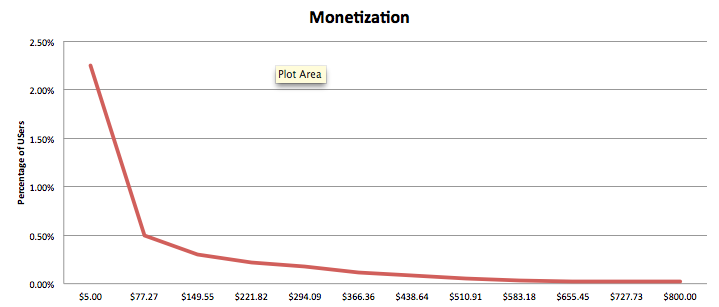The original version of the material can be found on Mobile Dev Memo, a website dedicated to the mobile industry, hosted by Eric Seferth himself, author of the book Freemium Economics. We continue to publish a series of articles “The Freemium Code”, compiled by Eric Benjamin Seufert, Head of Wooga Marketing Department.
Today his article about the freemium-monetization curve is next in line.
The freemium-monetization curve is continuousAudiences of freemium games are often divided into three groups:
- non-paying players (95-97% of users);
- those who spend a little (2-4%);
- whales (usually less than 1%).
But these groups are difficult to identify in most applications.
Firstly, when talking about such a classification, the temporary nature of such segmentation is ignored. For example, most of the “whales” at a certain point in time are users who spend a little.
Secondly, I simply do not believe that these groups are formed in this way, and if this happens, it is more likely the result of a weak monetization strategy than a property inherent in the user base.
The task of freemium is to gather as large an audience of users as possible into the application, scale the resulting user base into a number of monetization curves that cover (even if taking into account the huge difference between paying and non–paying users) a number of possible LTVs.
Now let’s imagine the freemium model as a market in the city center. Every stall in this market sells things for only $1 and $100. Question: In this case, won’t the labels “don’t buy”, “buy a little” and “buy a lot” hung on users be correct?
Of course, every visitor to the market will not spend $100. Moreover, most likely, the majority will not buy anything at all, but without offering a wide range of prices, sellers artificially create similar cohorts. Developers of freemium applications do the same, ignoring one of the main doctrines of this monetization model: users who like to buy things should be given the opportunity to do so in any quantity they deem necessary.
The vast majority of freemium application users will never purchase an IAP. And this is about 95%-97% of the entire audience. But the potential LCVs of those users who want to pay should be as diverse as possible (in other words, there should be a huge selection of products at completely different prices).
And now let’s see how the monetization line should look and work.
(caption: excerpt of the monetization curve, where the maximum LCV is $800 when reducing the user base to a paying audience)
Before reliable data is available, the freemium-monetization curve (or the curve of potential LCV prices) can be determined using the probability density of the Pareto distribution (22 distribution examples here): the segment cut off on the Y axis equal to 97% means that 97% of LCV users have 0.
The curve grows from this value through a number of potential LCVs to the maximum value that a player can spend in the project. Conceptually, the sum of the area of the curve (the LCV values on the abscissa axis and the possibilities on the ordinate axis user base) demonstrate the total amount of money that will be spent in the game by any tracked users.
Calculating fractional values on the ordinate axis is simple, but it should be done after the project is launched. After the benchmark values are set, the curve can be calculated by cohorts. After that, a behavioral forecast of all groups in the future can be given based on the LCV values obtained from the first users (for example, users who bought a certain item in their first session can repeat the purchase in the future).
If the freemium-monetization curve does not correspond to a continuous probability distribution (and a discrete distribution is assumed between “those who spend a little” and “whales”), it not only cannot be useful in forecasting, but also will not reflect the depth of the product catalog at higher levels.
For monetization at higher levels, increasing the tail of sales (monetization curve) – shareware application should offer products that meet the needs of strong players at the maximum of the “payment” spectrum.
The article was published as part of a joint series of materials “The Freemium Code” of mobile development sites App2Top.ru and Apptractor.ru .
Original material: http://mobiledevmemo.com/the-freemium-monetization-curve-is-continuous


